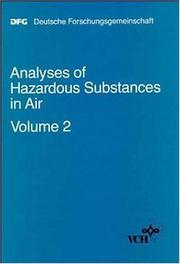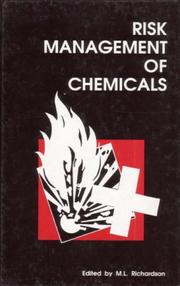| Listing 1 - 10 of 111 | << page >> |
Sort by
|
Book
ISBN: 928264510X Year: 1992 Publisher: Luxembourg Office for official publications of the European communities
Abstract | Keywords | Export | Availability | Bookmark
 Loading...
Loading...Choose an application
- Reference Manager
- EndNote
- RefWorks (Direct export to RefWorks)
Hazardous substances --- Health aspects --- Packaging --- European Economic Community countries --- -Hazardous substances --- -Dangerous chemicals --- Dangerous goods --- Dangerous materials --- Dangerous substances --- Hazardous chemicals --- Hazardous goods --- Hazardous materials --- Hazmats --- Chemicals --- Materials --- -Packaging --- -European Economic Community countries --- -Health aspects --- Dangerous chemicals

ISSN: 09467610 ISBN: 3527270264 3527270159 Year: 1991 Publisher: Weinheim VCH
Abstract | Keywords | Export | Availability | Bookmark
 Loading...
Loading...Choose an application
- Reference Manager
- EndNote
- RefWorks (Direct export to RefWorks)
-Indoor air pollution --- -Air --- Sick building syndrome --- Pollution, Indoor --- Indoor air pollution --- Hazardous substances --- Analysis --- Measurement --- Air --- Dangerous chemicals --- Dangerous goods --- Dangerous materials --- Dangerous substances --- Hazardous chemicals --- Hazardous goods --- Hazardous materials --- Hazmats --- Chemicals --- Materials --- Pollution --- Pollution [Indoor ] --- -Dangerous chemicals --- -Analysis
Book
ISBN: 9789264018587 Year: 2004 Publisher: Paris : OECD Publishing,
Abstract | Keywords | Export | Availability | Bookmark
 Loading...
Loading...Choose an application
- Reference Manager
- EndNote
- RefWorks (Direct export to RefWorks)
La deuxième édition complète de ces Principes vise à aider les pouvoirs publics, l'industrie et les collectivités dans le monde entier à anticiper les accidents résultant de catastrophes technologiques et naturelles ou de sabotages et impliquant des substances dangereuses. Elle aborde les thèmes suivants : prévention des accidents et quasi-accidents chimiques ; préparation aux accidents par l’élaboration de plans d’urgence, d’une communication avec le public, etc.; mesures à prendre pour faire face aux accidents et réduire autant que possible
Chemicals --- Hazardous substances --- Accidents --- Dangerous chemicals --- Dangerous goods --- Dangerous materials --- Dangerous substances --- Hazardous chemicals --- Hazardous goods --- Hazardous materials --- Hazmats --- Materials
Book
ISBN: 9789264221741 Year: 2014 Publisher: Paris : OECD Publishing,
Abstract | Keywords | Export | Availability | Bookmark
 Loading...
Loading...Choose an application
- Reference Manager
- EndNote
- RefWorks (Direct export to RefWorks)
This Guidance on Developing Safety Performance Indicators (“Guidance on SPI”) was prepared to assist enterprises that wish to implement and/or review Safety Performance Indicator Programmes. The three chapters in this Guidance are designed to help enterprises better understand safety performance indicators, and how to implement SPI Programmes. Specifically, Chapter 1 provides important background information on the Guidance and on SPIs more generally including (i) a description of the target audience for this Guidance, (ii) defi nitions of SPIs and related terms, and (iii) insights on the reasons for implementing an SPI Programme. Chapter 2 sets out a seven-step process for implementing an SPI Programme, along with three examples of how different types of enterprises might approach the establishment of such a Programme. These seven steps build on the experience of a number of enterprises in the UK that worked with the Health and Safety Executive to develop a practical approach for applying performance indicators. Chapter 3 provides additional support for the development of an SPI Programme by setting out a menu of possible elements (targets, outcome indicators and activities indicators). This menu is extensive in light of the different types of potentially interested enterprises, recognising that each enterprise will likely choose only a limited number of the elements to monitor its key areas of concern. Furthermore, it is understood that an enterprise may decide to implement an SPI Programme in steps, focusing fi rst on only a few priority areas, and then expanding and amending its Programme as experience is gained. Annexes provide further support with an expanded explanation of metrics and a summary of targets, along with a glossary, a list of selected references and a copy of the Guiding Principles’ “Golden Rules.”
Hazardous substances --- Chemicals --- Accidents --- Dangerous chemicals --- Dangerous goods --- Dangerous materials --- Dangerous substances --- Hazardous chemicals --- Hazardous goods --- Hazardous materials --- Hazmats --- Materials
Book
ISBN: 1461532221 Year: 1993 Publisher: New York, New York : Springer Science+Business Media, LLC,
Abstract | Keywords | Export | Availability | Bookmark
 Loading...
Loading...Choose an application
- Reference Manager
- EndNote
- RefWorks (Direct export to RefWorks)
Leon N. Moses In June 1991, the Transportation Center at Northwestern University sponsored Hazmat Transport '91: A National Conference on the Transportation of Hazardous Materials and Wastes. The faculty associated with the center were aware that there had been many professional, industrial and government conferences and meetings on the subject. However, they believed that the unique capacity of the Transportation Center to bring together leaders from industry and government, as well as leading scholars from economics, law, engineering, psychology and sociology who have done research on the problems associated with the transportation of hazardous materials and wastes (hazmats), could produce a set of integrated insights and understandings that would go well beyond those of previous conferences. The papers that make up this volume were all delivered at Hazmat Transport '91. From a legislative point of view, they tend to deal with issues associated with the Hazardous Materials Transportation Act of 1975 (HMTA), the original act passed to regulate the transportation of hazardous materials, and the Hazardous Materials Transportation Uniform Safety Act of 1990 (HMTVSA). There were talks and papers presented at the conference that focused on other recent legislation and transportation issues with which HMTUSA does not deal. The conference proceedings volume also had discussions and papers on significant managerial and regulatory issues that could not be included in this volume because of constraints on its size. Therefore, this essay is made up of three parts.
Hazardous substances --- Transportation --- Dangerous chemicals --- Dangerous goods --- Dangerous materials --- Dangerous substances --- Hazardous chemicals --- Hazardous goods --- Hazardous materials --- Hazmats --- Chemicals --- Materials
Periodical
ISSN: 23114614 Year: 2003 Publisher: Paris : OECD Publishing.
Abstract | Keywords | Export | Availability | Bookmark
 Loading...
Loading...Choose an application
- Reference Manager
- EndNote
- RefWorks (Direct export to RefWorks)
This series on chemical accidents covers such topics as safety performance indicators, accident prevention, preparedness for accidents and response to accidents.
Environment --- Chemicals --- Hazardous substances --- Accidents --- Dangerous chemicals --- Dangerous goods --- Dangerous materials --- Dangerous substances --- Hazardous chemicals --- Hazardous goods --- Hazardous materials --- Hazmats --- Materials
Book
ISBN: 039753020X Year: 1990 Publisher: Philadelphia (Pa.): Lippincott
Abstract | Keywords | Export | Availability | Bookmark
 Loading...
Loading...Choose an application
- Reference Manager
- EndNote
- RefWorks (Direct export to RefWorks)
Hazardous substances --- Schools --- Dangerous chemicals --- Dangerous goods --- Dangerous materials --- Dangerous substances --- Hazardous chemicals --- Hazardous goods --- Hazardous materials --- Hazmats --- Chemicals --- Materials --- Safety measures --- Chemical industry. --- Hazardous substances.

ISBN: 1782424954 1855738120 9781782424956 9781855738126 0851864678 Year: 1992 Publisher: Cambridge, England
Abstract | Keywords | Export | Availability | Bookmark
 Loading...
Loading...Choose an application
- Reference Manager
- EndNote
- RefWorks (Direct export to RefWorks)
Chemicals --- Hazardous substances --- Safety measures --- Dangerous chemicals --- Dangerous goods --- Dangerous materials --- Dangerous substances --- Hazardous chemicals --- Hazardous goods --- Hazardous materials --- Hazmats --- Materials --- Chemical compounds --- Compounds, Chemical --- Chemistry
Book
ISBN: 1281072664 9786611072667 0080540686 0444886567 9780080540689 9780444886569 9781281072665 Year: 1995 Publisher: New York : Elsevier,
Abstract | Keywords | Export | Availability | Bookmark
 Loading...
Loading...Choose an application
- Reference Manager
- EndNote
- RefWorks (Direct export to RefWorks)
Accidents involving reactive chemicals can often be prevented, or their effects alleviated, if those handling them have a sound knowledge both of their hazardous properties and of appropriate handling methods. This book addresses this need. It opens with a definition of the key technical terms and evaluation methods for hazardous materials are outlined. Chapter 2 covers accidents involving self-reactive substances, accidents occurring during chemical reactions, and accidents involving hazardous products in the event of an earthquake. In the next three chapters, methods for evaluating fire an
Hazardous substances --- Fireworks --- Safety measures. --- Testing. --- Pyrotechnics --- Pyrotechnists --- Dangerous chemicals --- Dangerous goods --- Dangerous materials --- Dangerous substances --- Hazardous chemicals --- Hazardous goods --- Hazardous materials --- Hazmats --- Chemicals --- Materials
Book
ISBN: 0444597840 1299194168 0444898638 9780444597847 9780444898630 Year: 1994 Publisher: Amsterdam New York Elsevier
Abstract | Keywords | Export | Availability | Bookmark
 Loading...
Loading...Choose an application
- Reference Manager
- EndNote
- RefWorks (Direct export to RefWorks)
Applications of the science of fluid mechanics to the new and expanding fields of industrial safety and environmental protection are discussed in this volume. The material is organized in accordance with the chain-of-events in real accidents, starting with the loss of containment of hazardous fluids, going on to the spreading and mixing processes in water or air, and ending with the damage loads caused by explosions, fires or toxic content. To develop solutions relevant to the wide range of problems considered, it is necessary to draw on material from various branches of fluid mechanics, i.e
Hazardous substances. --- Fluid mechanics. --- Hydromechanics --- Continuum mechanics --- Dangerous chemicals --- Dangerous goods --- Dangerous materials --- Dangerous substances --- Hazardous chemicals --- Hazardous goods --- Hazardous materials --- Hazmats --- Chemicals --- Materials
| Listing 1 - 10 of 111 | << page >> |
Sort by
|

 Search
Search Feedback
Feedback About UniCat
About UniCat  Help
Help News
News